Exploring Iconic Piano-Driven Songs and Their Impact
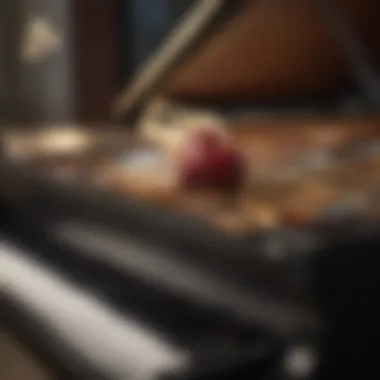
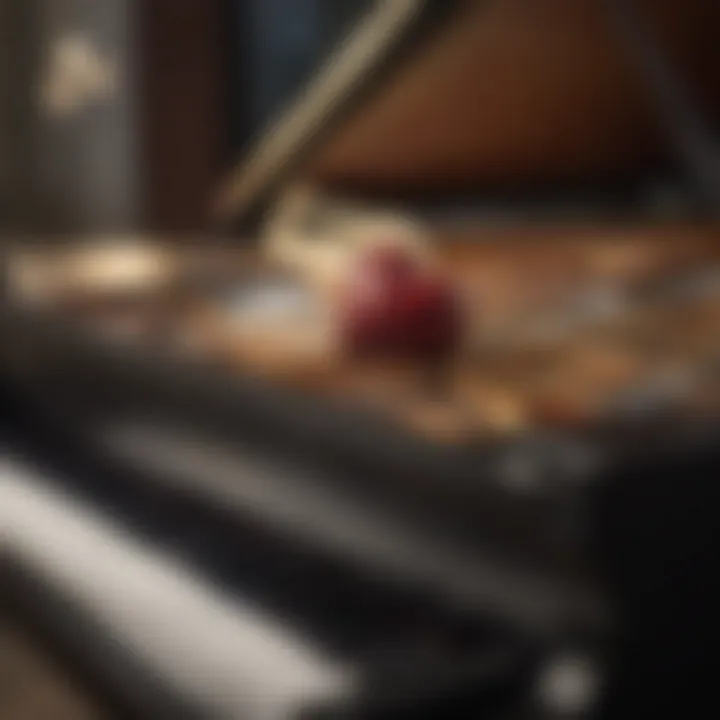
Intro
Piano serves as a powerful instrument in the realm of music, often laying the foundation for memorable melodies and heartfelt lyrics. A significant number of songs begin with the piano, showcasing not only the versatility of this instrument but also its ability to evoke deep emotions. This section delves into the artists behind these compositions, providing insight into their backgrounds and how their stories influence their musical creations.
Artist Profile
Biography and Background
Understanding the artist is crucial when analyzing songs that begin with the piano. Each artist brings unique experiences and cultural backgrounds that shape their music.
For instance, Elton John, a prominent figure in pop music, began playing piano at a young age. With a career spanning decades, his compositions often intertwine personal experiences with universal themes of love and resilience. Conversely, Tori Amos, known for her emotive style, utilizes her classical training to create intricate musical narratives. Her background as a trained musician informs her delicate yet powerful piano work, which sets the tone for many of her songs.
Major Influences and Inspirations
The influences on these artists vary widely. For Beethoven, the classical roots of piano music provide a rich foundation, while contemporary artists like Alicia Keys blend genres, integrating R&B and soul into their piano-centric works.
- Elton John: Influences include rock and roll legends, which shape his vibrant sound.
- Tori Amos: Draws on literary themes, often inspired by poetry and personal verse.
- Alicia Keys: Combines elements of jazz and soul to fully express her emotions through her music.
Understanding an artist's influences provides a clearer picture of how their work resonates with audiences.
Song Analysis
Theme and Lyrics Breakdown
Thematic elements in songs that start with piano often revolve around complex emotions. For example, "Someone Like You" by Adele opens with a haunting piano melody that mirrors the song’s themes of love and loss. Each line of the lyrics resonates deeply with listeners, inviting them into a shared emotional journey.
- Common Themes:
- Love and relationships
- Personal struggle and resilience
- Memory and nostalgia
Instrumentation and Composition
The piano's role transcends mere accompaniment. It shapes the compositional structure, often guiding the harmonic progression of a song. Tracks like "Clair de Lune" by Claude Debussy showcase how the piano can create atmospheric soundscapes, using arpeggios and subtle dynamics to evoke a range of feelings.
- Instrumentation Techniques:
- Use of arpeggios to create texture
- Harmonic shifts that enhance emotion
- Pedal techniques that add depth
Prelims
In the realm of music, the piano occupies a unique and significant position. This versatile instrument not only serves as a foundational element in various genres but also shapes the emotional landscape of songs. The focus on piano-driven compositions reveals deeper connections between melody and expression, allowing listeners and creators to explore a wide array of feelings and narratives.
Understanding the importance of piano in music entails examining its role in different styles, from classical and jazz to pop and rock. The piano's ability to convey complex emotions makes it a powerful tool for musicians and songwriters. By beginning songs with piano, artists can establish an atmosphere that resonates with the audience right from the first note, creating an immediate emotional impact.
This article will explore various piano-driven songs, presenting an all-encompassing analysis of their musical structures and functions. Highlighting significant works alongside lesser-known gems will illustrate how this instrument contributes to the richness of contemporary music. As readers progress through the sections, they will gain insights into the nuanced relationship between piano and song composition, along with an appreciation for the artistry involved in crafting piano-centric music.
The Significance of Piano in Music
The piano's significance in the broader landscape of music cannot be overstated. Its multifaceted nature allows for both melodic and harmonic exploration. The instrument serves as a bridge between rhythm and melody, providing a comprehensive toolkit for musicians. The distinction of being both a solo and ensemble instrument enhances its relevance in various musical settings.
In classical music, composers like Ludwig van Beethoven and Frédéric Chopin have created works that highlight the piano's expressive potential. Similarly, in more contemporary genres, artists such as Elton John and Adele have used piano to anchor their emotional storytelling. The piano facilitates not just the dissemination of musical ideas, but also the connection to listeners on a more profound level.
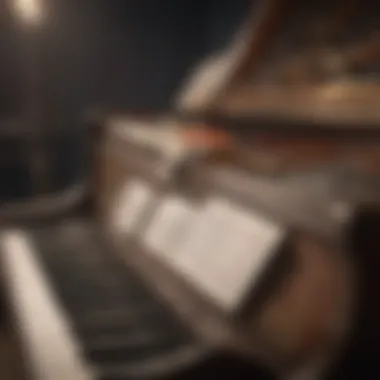

Overview of Piano-Driven Songs
Piano-driven songs encompass a vast array of styles and themes, reflecting the adaptability of this instrument. The opening notes of a piece can set the tone, signaling to the audience what they can expect in terms of mood and lyrical content. Examples of notable tracks include "Clair de Lune" by Claude Debussy, which conveys serenity through its flowing piano lines, and "Someone Like You" by Adele, where the piano serves as a poignant backdrop to the vocal performance.
Moreover, it is worth noting that piano songs often possess a timeless quality. They often blend well with shifts in musical trends, making them enduring staples across generations. Familiarity with these compositions enables fans to appreciate their depth and artistry. Songs like "Let It Be" by The Beatles showcase the piano as an essential element in crafting both memorable melodies and relatable lyrics.
Through this article, readers will be guided in their exploration of iconic piano-driven compositions and the emotional resonance they carry. It highlights how these songs leverage the capabilities of the piano to create memorable moments in music history.
Historical Context of Piano in Music
The historical framework of piano music is essential for understanding its profound significance in the landscape of music. This section explores two core aspects: the origins of piano music and its evolution over the decades. These insights provide a roadmap to comprehending how piano compositions have shaped both musical styles and artists' creative expressions throughout history.
Origins of Piano Music
The origins of piano music can be traced back to the early 18th century. The piano evolved from earlier keyboard instruments like the harpsichord and clavichord. The invention by Bartolomeo Cristofori led to the creation of the first true pianoforte. This instrument allowed musicians to vary the dynamics of their play, a feature that distinguished it from its predecessors. The ability to produce both soft and loud sounds was significant in enriching musical expression.
Initially, piano music was primarily associated with the courts and aristocracy, played by skilled musicians at social gatherings. The compositions during this era were characterized by intricate patterns and delicate phrases. Influential composers, such as Johann Sebastian Bach and Ludwig van Beethoven, began to write pieces that exploited the piano's dynamic capabilities. These pioneers laid a solid foundation for future generations, emphasizing the piano's role as a versatile instrument in various musical genres.
Evolution Through the Decades
As the centuries progressed, the piano underwent substantial transformations in style and technology. The 19th century marked a period of great innovation. Piano manufacturing improved significantly, giving rise to instruments that enhanced sound quality and responsiveness. This was the era of Romanticism, where composers like Frédéric Chopin and Franz Liszt created works that emphasized emotional expression and technical prowess.
- Technological Advancements:
- Shift in Musical Styles:
- Introduction of cast-iron frames, improving durability and volume.
- Development of the upright piano, making it more accessible to the middle class.
- Transition from Classical to Romantic styles, focusing on personal expression.
- Emergence of new genres, including ragtime and jazz, which integrated piano as a leading instrument.
The 20th century further diversified the role of the piano in music. Genres like blues and rock established the piano not just as a classical instrument but also as a core part of popular music. The influence of jazz pushed the boundaries of improvisation, allowing musicians to express themselves freely while intertwining various influences from cultural backgrounds.
"The evolution of piano music reflects society's changing values and artistic expressions, shaping the way we understand modern music today."
The piano stone laid during its early years continues to resonate in contemporary music. With emerging challenges and innovations, the piano's journey opens avenues for new exploration and creativity in the musical realm. Understanding this historical context enables a deeper appreciation for the songs that commence with this multifaceted instrument.
Genre-Specific Analysis
Understanding genre-specific analysis in the context of piano-driven songs is essential for grasping how various musical styles utilize the piano to create unique auditory experiences. Each genre not only informs the composition style but also the emotional resonance of the piece. By exploring these specific genres, we can appreciate the nuanced role that the piano plays in expressing different themes, cultural references, and artistic intentions. Moreover, examining diverse genres reveals how the piano continues to influence modern music across various forms and settings.
Piano in Classical Music
Classical music showcases the piano’s intricate abilities as both a solo and accompaniment instrument. Composers like Ludwig van Beethoven and Frédéric Chopin wrote extensively for piano, creating works that are still revered today. The piano in classical music often serves to convey a range of emotions, from the dramatic to the serene. Its capability to play multiple voices simultaneously allows for complex harmonic structures, enhancing the listener's experience. The structure typically follows more rigorous forms, such as sonatas or concertos, showcasing technical prowess and emotional depth. These forms have profoundly influenced later music genres, ensuring that the piano remains a staple in musical composition.
Blues and Jazz Influences
Blues and jazz reveal a different side of the piano. Here, the instrument plays a pivotal role in improvisation. Pianists like Thelonious Monk and Ray Charles utilized the expressive range of the piano, allowing for spontaneous musical dialogues that capture raw emotion. In the blues tradition, the piano often serves as a vehicle for storytelling. The melodies are simple yet powerful, allowing performers to infuse personal experiences into their music. Jazz, on the other hand, uses the piano to create intricate harmonies and rhythms, pushing the boundaries of traditional forms. This blend of structure and spontaneity highlights the piano's versatility, making it essential in shaping these genres.
Pop and Contemporary Selections
In pop music, the piano serves both rhythmic and melodic purposes. Artists like Adele and Coldplay use piano introductions to establish mood and draw in listeners right from the first note. The simplicity of the chord progressions paired with catchy melodies makes these songs accessible, yet emotionally resonant. Contemporary trends often integrate electronic elements alongside traditional piano arrangements, pushing the boundaries of how the piano is perceived in modern music. Moreover, the emotional depth conveyed through piano in pop helps in relatability and connection with audiences, which is vital for commercial success.
Piano in Rock and Alternative Music
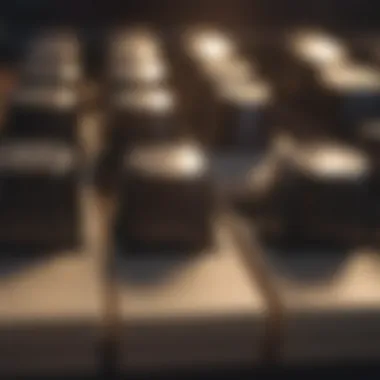
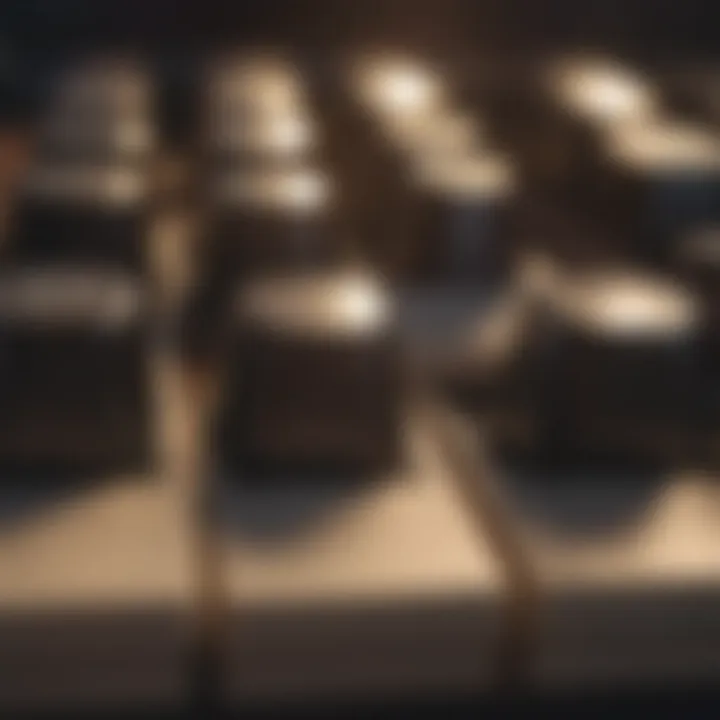
The impact of piano in rock and alternative music cannot be overlooked. Bands like Queen and Radiohead have skillfully incorporated piano into their compositions, creating powerful ballads and anthems. The piano adds a layer of sophistication to rock genre, enhancing emotional expression and providing contrast to electric guitars. In alternative music, where experimentation is encouraged, the piano often drives the composition's mood, contributing to the overall soundscape. Its presence often signifies a change in dynamics, creating tension and releases that keep the listener engaged, and offering a different texture compared to traditional rock instrumentation.
Iconic Songs That Start with Piano
The significance of iconic songs that commence with piano is undeniable. This section examines how these songs shape the overall musical landscape. Piano-driven songs often set a specific tone and mood right from the start. They can evoke emotions, grab attention, and engage listeners in a unique way. The analysis of such songs serves as a critical step in understanding the broader musical narrative.
Analysis of Selected Tracks
Track One: Background and Overview
One iconic track that begins with piano is "Clair de Lune" by Claude Debussy. This piece is pivotal due to its impressionistic style that deeply influences listeners. The soft, flowing melodies are characterized by nuanced dynamics and harmonic textures. It is a beneficial choice for this article, as it emphasizes the piano's emotive power. The unique aspect of "Clair de Lune" is its ability to convey complex feelings without the need for lyrics. This track showcases how piano can create a profound listening experience, contributing to the discourse on emotional depth in music.
Track Two: Musical Composition
Another notable piece is "Someone Like You" by Adele. The song begins with a simple yet striking piano arrangement that captures attention immediately. The composition features a blend of minor chords and a steady rhythm that enhances its emotive weight. Its popularity stems from its relatable lyrics coupled with the raw emotion in Adele's voice. The unique characteristic here is the use of a repetitive but heartfelt melody that resonates long after the song ends. This track highlights the piano's role as a central instrument in effective pop songwriting.
Track Three: Emotional Resonance
The song "River Flows in You" by Yiruma represents a modern approach to piano music. It is widely known for its emotional resonance, often considered a love theme. The flowing, continuous notes create an atmosphere of intimacy and connection. This piece is beneficial for our discussion as it exemplifies how contemporary artists leverage the piano for emotional storytelling. One distinct feature of this track is its minimalist structure that allows listeners to project their feelings and narratives onto the music.
Lesser-Known Gems
Hidden Track One: Insights and Importance
One lesser-known gem is "The Night We Met" by Lord Huron. It showcases subtle piano chords that weave throughout the track. Its importance lies in how it uses the piano to build haunting ambiance. The unique feature is its slow tempo and the gradual layering of instruments that evoke a sense of nostalgia. This track holds significant weight in demonstrating how lesser-known songs can achieve emotional depth through simple piano work.
Hidden Track Two: A Brief History
“Comptine d’un autre été: L'après-midi” by Yann Tiersen presents a rich history behind its composition. Known primarily from the film "Amélie," it reaches back to the early 2000s. The track provides an appealing contrast to mainstream songs with its quaint simplicity. Highlighting the interplay between notes, it creates a dreamy atmosphere. Its advantages in the context of this article stem from showcasing the piano's power to evoke visual imagery and emotional landscapes without overwhelming production.
The Role of Piano in Artistry
The piano holds a distinct place in music that transcends genres and styles. Its versatility allows for a broad range of expression, making it a crucial component in the artistry of numerous compositions. When analyzing songs that begin with piano, it becomes evident that this instrument serves not merely as an accompaniment but as the backbone of creative exploration. This section delves into how the piano as a creative tool influences the music industry and shapes songwriting trends.
Piano as a Creative Tool
Using the piano as a creative tool can unlock new avenues for musicians and composers. Its capability to produce both melody and harmony simultaneously means that artists can explore complex musical ideas more freely. For example, many musicians find inspiration in how the piano allows them to juxtapose elegant melodies with rich chord structures. This dual nature enables artists to experiment with sound and emotion, leading to significant breakthroughs in their work.
Notably, the tactile and visual aspects of playing the piano contribute to its effectiveness. Musicians can easily visualize their compositions, seeing how notes connect on the staff while also hearing how they blend in practice. This hands-on experience can enhance creativity, allowing for a fluid connection between thought and sound.
In contemporary music, we see many artists harness the power of the piano. Not just in classical pieces but also in genres like pop and rock. Songs by Adele, for example, often begin with a striking piano part, setting an emotional tone that resonates with listeners. The simplicity of the piano allows for complex feelings to shine through, making it an ideal choice for powerful ballads.
Influencing Songwriting Trends
The influence of the piano on songwriting cannot be overstated. Throughout the decades, it has been the driving force behind significant trends in music composition. It is often said that trends emerge not only from lyrics or vocal styles but also from the musical foundation on which songs are built.
As genres evolve, the piano continues to play a pivotal role. For instance, the rise of singer-songwriters in the late 20th century showcased the piano’s ability to support storytelling through melody. Artists like Billy Joel and Norah Jones have demonstrated how piano-driven songs can craft narratives that reflect personal experiences. Their works often blend lyrical simplicity with harmonic sophistication, illustrating the piano's unique position in crafting memorable songs.
Moreover, the digital revolution has altered how music is created, but the piano remains at the heart of much of this innovation. Digital audio workstations often feature piano sounds and MIDI controllers enable musicians to compose in new ways while preserving the piano's qualities.
"The piano acts as a bridge, connecting the minds of artists with the emotions of the audience."
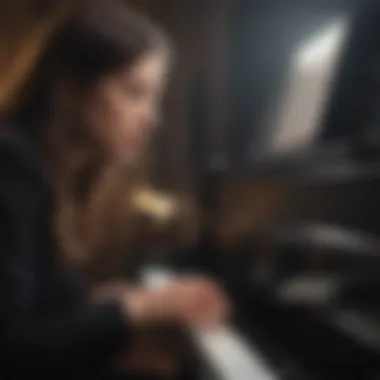
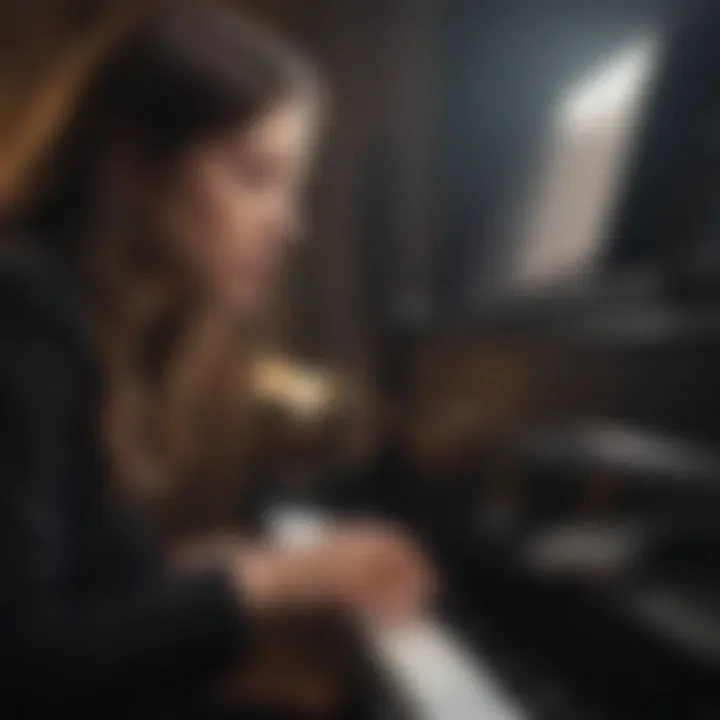
Cultural Impact of Piano Songs
The cultural impact of piano songs is profound and multifaceted. Piano music has shaped our shared experiences across various artistic domains, embedding itself into the very fabric of popular culture. Through film, television, and societal movements, these compositions evoke emotions that resonate with individuals on multiple levels.
A significant aspect of this impact is the way that piano-driven songs convey universal themes of love, loss, and triumph. They often provide a soundtrack to pivotal moments in people's lives, acting as a bridge that connects listeners to their deepest emotions. This connectivity is not merely anecdotal; it is substantiated by studies that indicate how music influences mood and behavior.
Furthermore, piano songs have been crucial in highlighting social issues. Many contemporary artists use their platforms to address topics such as mental health, inequality, and personal struggles, effectively merging their art with advocacy. The piano serves as an accessible instrument, making it a favorable choice for artists expressing their messages, whether on grand stages or in intimate settings.
"A well-composed piano piece can evoke a memory or feeling long after the final note fades, demonstrating the piano's enduring relevance in our lives."
Piano Songs in Film and Television
The integration of piano music into film and television is significant. It provides an emotional undercurrent that guides the viewer's experience. Iconic scenes often feature piano melodies that are memorable, enhancing the narrative and enriching character development. Films like The Piano and shows such as This Is Us use piano compositions to convey complex feelings and instill lasting impressions.
Watching a film or series, we find that the piano can subtly sway our emotional responses. For instance, a delicate piano score might underline a poignant moment, while a strong, rhythmic piece can amplify tension or excitement. This dynamic underscores how integral piano music is in storytelling across different media.
Piano Music and its Influence on Society
Piano music often transcends mere entertainment, influencing societal norms and sentiments. Rhythms and harmonies from piano compositions find their way into social movements, empowering collective action and enhancing communal experiences. Think of protest songs that use the piano to amplify their messages; these pieces often underscore calls for justice and change, which resonate deeply with listeners.
The versatility of the piano allows it to adapt to various genres and styles, making it a vehicle for different cultural expressions. From classical concert halls to modern pop arenas, its presence is felt everywhere. Furthermore, as more educational institutions emphasize music studies, the piano serves as a foundational instrument that introduces many to the world of music. This accessibility gives rise to new generations of musicians and music lovers, fostering a community built on shared values and experiences, which in turn, influences surrounding cultures.
In summary, the cultural impact of piano songs is vast, extending into film, television, and society at large. The piano not only communicates profound emotional truths but also plays a critical role in the evolution and expression of culture. Embracing its legacy is essential for understanding its current and future relevance in the arts.
Contemporary Trends in Piano Music
The landscape of piano music is undergoing significant changes. As technology and culture shift, the role of the piano in modern compositions evolves. Understanding these contemporary trends is crucial for music enthusiasts, aspiring musicians, and students who seek to grasp the nuances of today's musical environment.
One of the main elements shaping current piano music is the integration of digital innovations. With the advent of software like Ableton Live and GarageBand, musicians increasingly blend traditional piano sounds with electronic elements. This fusion opens up new creative avenues, enabling artists to experiment with sound in an unprecedented way. Benefits include enhanced accessibility to music production tools, allowing individuals from diverse backgrounds to produce high-quality tracks effortlessly.
Moreover, these innovations facilitate collaboration among artists globally. Musicians can now connect online, share their work, and even contribute to collaborative projects without geographical limitations. Consequently, we observe a surge in cross-genre experimentation, where piano music assimilates elements from various styles,
In addition, the emergence of new artists in the piano realm is noteworthy. From solo pianists crafting unique interpretations to bands integrating the piano into their core sound, contemporary talents are redefining what piano music can be. Emerging artists often draw from a rich tapestry of influences, including classical, jazz, pop, and even hip-hop. Their ability to blend these influences showcases the piano as a versatile instrument that transcends genre boundaries.
Notable names include composers like Ludovico Einaudi, whose minimalist approach invites listeners into introspective soundscapes. Similarly, artists such as Hania Rani combine cinematic elements with classical traditions, arousing deep emotions in their audiences. These individuals not only contribute to the evolving piano narrative but also inspire the next generation of pianists and composers.
The future of piano music appears bright and promising. As individuals continue to explore the potentials of this instrument, we can anticipate a rich diversity in sound and style. The integration of technology, alongside a spirit of experimentation, ensures that piano music remains a compelling part of the broader musical dialogue.
"The role of technology in music is growing, and pianists must adapt to remain relevant in the modern landscape."
This evolution reflects not just the changing tones of our times, but also the inherent adaptability of the piano. It is essential for today's musicians to remain aware of these shifts, embracing change while honoring the traditional aspects that have long characterized piano music.
End
In summarizing the discussion on songs that initiate with piano, it becomes evident that this instrument holds a profound significance in the realm of music. The piano serves not only as a melodic foundation but also as a medium for emotional expression. Throughout this article, we have examined various genres and iconic songs, each revealing the piano's versatility.
Reflection on Piano's Legacy
The legacy of piano music is deeply interwoven with the evolution of contemporary music. From Chopin's delicate nocturnes to modern pop ballads, the piano has transformed how artists express themselves. Its ability to convey complex emotions makes it a preferred choice for many songwriters. The piano acts as both a solo and harmonic instrument, providing a rich texture that supports vocals and complements other instruments. This dual role has firmly established the piano as a cornerstone in musical history, with its influence felt in countless genres.
The artistry of the piano transcends mere technicality; it encapsulates cultural narratives and personal stories. The evolution of piano music reflects broader societal changes, marking significant historical transitions. For instance, the infusion of blues and jazz into mainstream music reshaped the soundscape of the 20th century. Additionally, piano music often serves as an introduction to classical training for many aspiring musicians, further solidifying its relevance in educational contexts.
Future of Piano Music
Looking ahead, the future of piano music appears promising, particularly with the integration of technology. Digital innovations provide musicians with new creative avenues. Software such as GarageBand and Ableton Live allows for sophisticated arrangements and compositions that were once limited to professional studios. This democratization of music production fosters a new generation of musicians who can experiment and share their work easily.
Moreover, the rise of online platforms encourages collaboration among artists across the globe. Emerging artists often showcase their skills through social media, where piano covers and original compositions can reach a vast audience. This interconnectedness has the potential to refresh traditional forms, breathing new life into classical and modern piano music.







